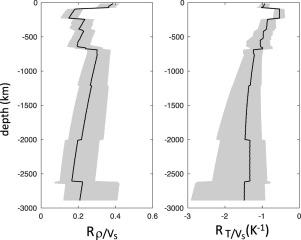Physics of the Earth and Planetary Interiors ( IF 2.3 ) Pub Date : 2021-07-16 , DOI: 10.1016/j.pepi.2021.106772 C. Adam 1 , S.D. King 2 , M.J. Caddick 2

|
Deriving a quantitative geodynamical interpretation from tomography models is a difficult task. It is also a timely task, particularly given the many high-resolution tomography models published in recent years. It is important to assess mantle structure in terms of density and temperature anomalies. Here, we provide a new estimation of the conversion factors between seismic velocity anomalies and density anomalies, Rρ/v, and between seismic velocity anomalies and temperature anomalies, RT/v. These conversion factors are found by considering the constraints provided by thermodynamics, the influence of melt, and anelasticity. To determine the elastic component, we performed thermodynamic simulations by considering several compositions representative of normal or plume-enriched mantle. We also explore the effects of the presence of melt on seismic velocity and consider a radial attenuation profile to account for anelasticity. We provide an envelope of acceptable models, by combining the range of possible solutions combining the elastic, anelastic, and melt relationships used in deriving the conversion factors. Several of the frequently used velocity-density scaling relationships are encompassed in this envelope. We assess the validity of our result by calculating temperature anomalies from the tomographic models using our scaling relationships—these anomalies lie within the range constrained by melting temperatures registered in volcanic rocks (±300 K). Further, we show that the geoid model computed through our velocity-density scaling from the S40RTS tomography provides a good fit to the observed geoid.
中文翻译:

地幔温度和密度异常:热力学公式、熔体和非弹性的影响
从层析成像模型中得出定量的地球动力学解释是一项艰巨的任务。这也是一项及时的任务,特别是考虑到近年来发布的许多高分辨率断层扫描模型。根据密度和温度异常评估地幔结构很重要。在这里,我们提供了地震速度异常和密度异常之间的转换因子R ρ/v以及地震速度异常和温度异常之间的转换因子R T/v的新估计. 这些转换因子是通过考虑热力学提供的约束、熔体的影响和非弹性来找到的。为了确定弹性分量,我们通过考虑几种代表正常或富含羽流的地幔的成分进行了热力学模拟。我们还探讨了熔体的存在对地震速度的影响,并考虑径向衰减剖面来解释非弹性。我们提供了一系列可接受的模型,通过组合可能的解决方案范围,结合用于推导转换因子的弹性、非弹性和熔体关系。几个常用的速度-密度缩放关系都包含在这个包络中。我们通过使用我们的比例关系计算来自层析模型的温度异常来评估我们结果的有效性 - 这些异常位于火山岩中记录的熔化温度 (±300 K) 的限制范围内。此外,我们表明,通过 S40RTS 层析成像的速度-密度缩放计算的大地水准面模型提供了对观测大地水准面的良好拟合。



























 京公网安备 11010802027423号
京公网安备 11010802027423号